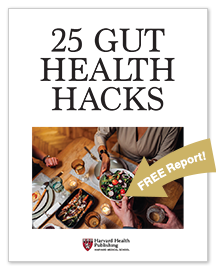
5 timeless habits for better health

What are the symptoms of prostate cancer?

Is your breakfast cereal healthy?

When pain signals an emergency: Symptoms you should never ignore

Does exercise give you energy?

Acupuncture for pain relief: How it works and what to expect

How to avoid jet lag: Tips for staying alert when you travel

Biofeedback therapy: How it works and how it can help relieve pain

Best vitamins and minerals for energy

Should you take probiotics with antibiotics?
Diseases & Conditions Archive
Articles
Hit hard by POTS
Postural orthostatic tachycardia syndrome (POTS) affects up to a million Americans, more than three-quarters of whom are women. A main feature of POTS is an intolerance to being upright. Symptoms include heart rate spikes, palpitations, dizziness, and fatigue. Risk factors include recent viral infection, surgery, concussion, or a long period of inactivity. POTS symptoms can be managed through exercising, drinking more fluids, increasing salt intake, wearing compression garments, and using counter-pulsation poses.
Not just another headache
Headaches happen to people every day, and about 4% of Americans report being bothered a great deal by them in the past three months. Only a tiny percentage of headaches indicate a serious underlying problem. Red-flag signs include headaches occurring with other symptoms; new headaches in people over 50; headaches that get worse with exercise, sex, coughing, or lying down; and "thunderclap" headaches that involve rapidly worsening head pain. People experiencing these signs should seek prompt medical attention.
When are nosebleeds a problem?
Nosebleeds are common, and dry air is the most prevalent cause. Other triggers include allergies, blood-thinning medications, or a deviated septum. People with frequent, heavy nosebleeds may need evaluation for a more serious underlying condition.
Sedentary work may contribute to insomnia
A 2025 study suggested that people with sedentary jobs are at higher risk of developing insomnia, which can persist for many years.
Diabetes drugs may improve risks for some conditions, but worsen others
A 2025 analysis suggested that GLP-1 medications used for diabetes and weight loss are associated with lower risks for an array of conditions, but that they increase risks for several others.
Do you really need bunion surgery?
Surgery is usually warranted when bunion pain becomes disabling, a skin ulcer develops, or it's necessary to prevent a bunion from dislocating the second toe. However, recovery can be long and painful, and there's no guarantee that bunions won't come back. Prior to surgery, it might help to use strategies that reduce bunion pain, such as adding cushioning to shoes, stretching shoes where a bunion rubs against them, getting roomier shoes or shoes made with stretchy fabrics, and using toe spacers.

5 timeless habits for better health

What are the symptoms of prostate cancer?

Is your breakfast cereal healthy?

When pain signals an emergency: Symptoms you should never ignore

Does exercise give you energy?

Acupuncture for pain relief: How it works and what to expect

How to avoid jet lag: Tips for staying alert when you travel

Biofeedback therapy: How it works and how it can help relieve pain

Best vitamins and minerals for energy

Should you take probiotics with antibiotics?
Free Healthbeat Signup
Get the latest in health news delivered to your inbox!
Sign Up








